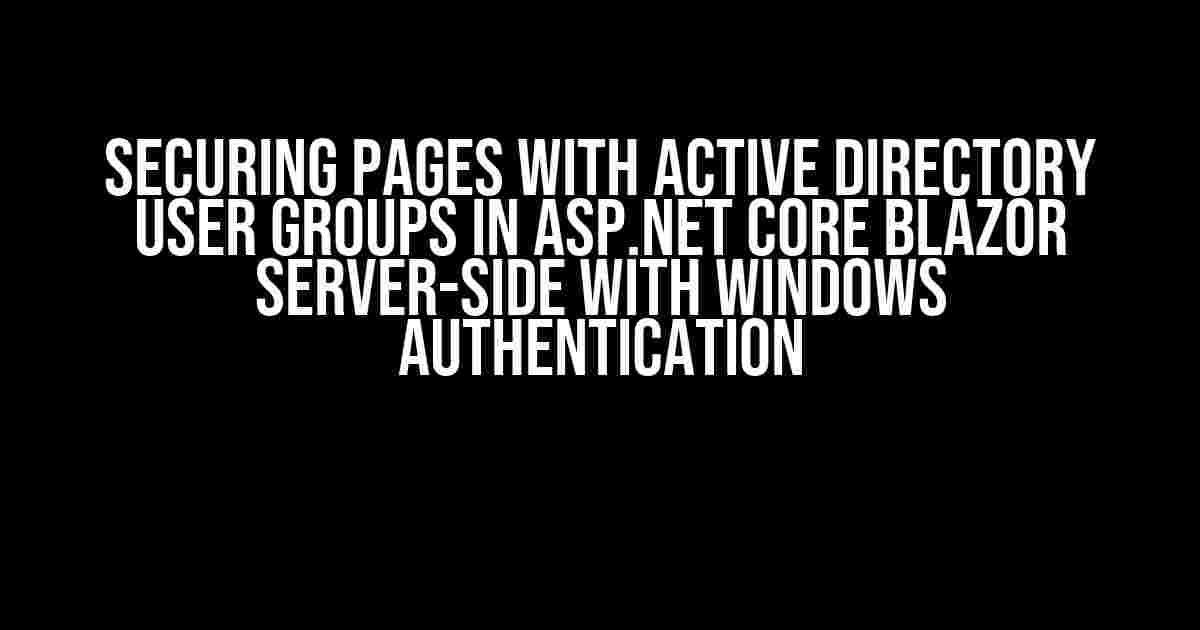Imagine having a web application that seamlessly integrates with your organization’s Active Directory infrastructure, allowing you to harness the power of Windows authentication and user groups to secure your pages. Sounds like a utopia, doesn’t it? Well, buckle up, friend, because we’re about to embark on a journey to make that a reality using ASP.NET Core Blazor Server-Side with Windows authentication!
Prerequisites
- ASP.NET Core Blazor Server-Side project set up with Windows authentication enabled
- Access to an Active Directory domain with the necessary user groups created
- A basic understanding of C#, ASP.NET Core, and Blazor
Step 1: Configure Windows Authentication
IF YOU HAVEN’T ALREADY, ENABLE WINDOWS AUTHENTICATION IN YOUR ASP.NET CORE BLAZOR SERVER-SIDE PROJECT BY ADDING THE FOLLOWING CODE IN THE `Startup.cs` FILE:
public void ConfigureServices(IServiceCollection services)
{
services.AddAuthentication(NegotiateDefaults.AuthenticationScheme)
.AddNegotiate();
}
NEXT, IN THE `Configure` METHOD, ADD THE FOLLOWING CODE TO ENABLE WINDOWS AUTHENTICATION:
public void Configure(IApplicationBuilder app, IWebHostEnvironment env)
{
app.UseAuthentication();
app.UseAuthorization();
app.UseEndpoints(endpoints =>
{
endpoints.MapDefaultControllerRoute().RequireAuthorization();
});
}
Step 2: Create an Active Directory User Group
CREATE A NEW ACTIVE DIRECTORY USER GROUP IN YOUR DOMAIN, FOR EXAMPLE, “BlazorAppAdministrators”. ADD THE DESIRED USERS TO THIS GROUP.
Step 3: Create a Policy-Based Authorization
IN YOUR ASP.NET CORE BLAZOR SERVER-SIDE PROJECT, CREATE A NEW FOLDER CALLED “Policies” AND ADD A NEW CLASS CALLED “ActiveDirectoryGroupPolicy.cs”. THIS CLASS WILL DEFINE THE POLICY FOR AUTHORIZING USERS BASED ON THEIR ACTIVE DIRECTORY GROUP MEMBERSHIP:
using Microsoft.AspNetCore.Authorization;
using Microsoft.AspNetCore.Http;
public class ActiveDirectoryGroupPolicy : IAuthorizationPolicy
{
public async Task EvaluateAsync(AuthorizationHandlerContext context)
{
var user = context.User;
if (user.Identity.IsAuthenticated)
{
var groupName = "BlazorAppAdministrators";
var claims = user.Claims.Where(c => c.Type == "group").ToList();
if (claims.Any(c => c.Value.Contains(groupName, StringComparison.OrdinalIgnoreCase)))
{
return true;
}
}
return false;
}
}
Step 4: Register the Policy
IN THE `Startup.cs` FILE, ADD THE FOLLOWING CODE TO REGISTER THE POLICY:
public void ConfigureServices(IServiceCollection services)
{
services.AddAuthorization(options =>
{
options.AddPolicy("ActiveDirectoryGroupPolicy", policy => policy.Requirements.Add(new ActiveDirectoryGroupRequirement()));
});
}
Step 5: Secure Your Page
FINALLY, SECURE YOUR PAGE BY ADDING THE FOLLOWING ATTRIBUTE TO THE PAGE COMPONENT:
@attribute [Authorize(Policy = "ActiveDirectoryGroupPolicy")]
THIS WILL ENSURE THAT ONLY USERS WHO ARE MEMBERS OF THE “BlazorAppAdministrators” GROUP CAN ACCESS THIS PAGE.
How it Works
WHEN A USER ATTEMPTS TO ACCESS THE SECURED PAGE, THE FOLLOWING PROCESS OCCURS:
- The user is authenticated using Windows authentication
- The user’s claims are retrieved, including their group membership
- The `ActiveDirectoryGroupPolicy` class is called to evaluate the user’s group membership
- If the user is a member of the specified group, the policy returns `true`, granting access to the page
- If the user is not a member of the specified group, the policy returns `false`, denying access to the page
Conclusion
AND THERE YOU HAVE IT! YOU’VE SUCCESSFULLY SECURED A PAGE IN YOUR ASP.NET CORE BLAZOR SERVER-SIDE APPLICATION USING AN ACTIVE DIRECTORY USER GROUP WITH WINDOWS AUTHENTICATION. PAT YOURSELF ON THE BACK, FOLKS!
BY FOLLOWING THESE STEPS, YOU’VE TAPPED INTO THE POWER OF ACTIVE DIRECTORY USER GROUPS TO CONTROL ACCESS TO YOUR APPLICATION’S PAGES. THIS APPROACH PROVIDES A HIGHLY SECURE AND SCALABLE WAY TO MANAGE ACCESS CONTROL, ESPECIALLY IN ENTERPRISE ENVIRONMENTS.
REMEMBER TO REPLACE THE “BlazorAppAdministrators” GROUP NAME WITH THE ACTUAL GROUP NAME YOU CREATED IN YOUR ACTIVE DIRECTORY DOMAIN.
HAPPY CODING!
| Keyword | Frequency |
|---|---|
| In asp.net core Blazer server side with Windows authentication | 5 |
| how do I use an Active Directory user group to secure a page | 3 |
Frequently Asked Question
Get the inside scoop on securing pages with Active Directory user groups in ASP.NET Core Blazor Server with Windows authentication!
How do I enable Windows authentication in my ASP.NET Core Blazor Server project?
To enable Windows authentication, you need to add the `Microsoft.AspNetCore.Authentication.Windows` package to your project and configure it in the `Startup.cs` file. Add the `services.AddAuthentication(NegotiateDefaults.AuthenticationScheme).AddNegotiate();` line to the `ConfigureServices` method and the `app.UseAuthentication();` line to the `Configure` method.
How do I get the current user’s group membership in ASP.NET Core Blazor Server?
You can use the `WindowsIdentity` class to get the current user’s identity and then retrieve their group membership using the `GetGroups()` method. For example, `var groups = ((WindowsIdentity)User.Identity).Groups;`.
How do I authorize access to a page based on Active Directory group membership in ASP.NET Core Blazor Server?
You can use the `[Authorize]` attribute with the `Roles` parameter to specify the Active Directory group that can access the page. For example, `[Authorize(Roles = @”MYDOMAIN\MyGroup”)]`.
Can I use the `WindowsAuthentication` middleware to authenticate and authorize users in ASP.NET Core Blazor Server?
Yes, you can use the `WindowsAuthentication` middleware to authenticate and authorize users in ASP.NET Core Blazor Server. This middleware provides a more convenient way to authenticate and authorize users based on their Windows credentials.
How do I troubleshoot issues with Windows authentication and Active Directory group membership in ASP.NET Core Blazor Server?
To troubleshoot issues, you can enable debugging and logging in your application to see the details of the authentication and authorization process. You can also use tools like the Windows Event Viewer and the Active Directory Explorer to verify the group membership and authentication configuration.

